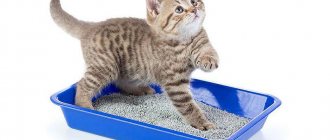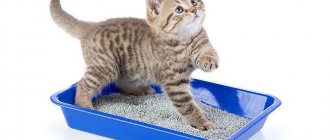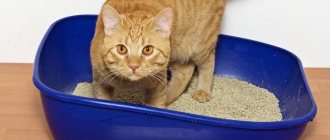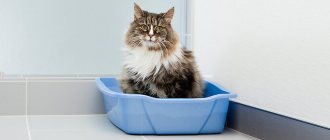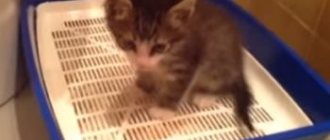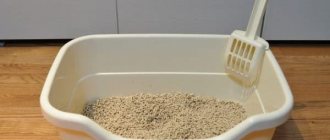Home » Useful Information
How to train a kitten to go to the litter box? Very simple!
You will need to set aside a little time, be patient and take into account the important advice of veterinarians.
The result will be achieved quickly if you simultaneously take into account the pet’s character and start the training process on time.
When a fluffy ball appears in the house, all family members are filled with a feeling of joy.
But immediately after a small puddle and other not-so-fragrant “traces of a crime” are discovered in one of the corners, euphoria gives way to disappointment, and sometimes even irritation.
And to prevent this from happening in the future, it is enough to know how to teach a kitten to go to the litter box. All it takes is a little patience, time and attention.
In fact, it's quite easy to instill good manners in him.
- 2 Tray selection
- 3 Space for tray
- 4 Training - basics
- 5 Express method
Age matters, where to start?
The age of the animal plays an important role in litter training.
The age of the animal plays an important role in litter training.
An adult has developed habits (especially if the cat is picked up from the street or purchased from breeders who release pets onto the street). The best age to train a kitten to use a litter tray is between 3 and 8 months.
Younger kittens, especially if they have been weaned from their mother cat, do not yet have a complete picture and understanding of the world around them. Once in a new apartment with the owner, the kids experience a lot of stress, for this reason they cannot immediately get accustomed to the tray.
The process of training a kitten to use a litter tray consists of the following steps:
- Choose a tray or other container.
- Select the type of filler.
- Choose a convenient place where the owner and the animal will not interfere with each other.
Acts of bowel movements and urination at different ages
A healthy kitten visits the restroom often. The health of the kitten depends on the number of visits, so it is important for a loving owner to monitor the rhythm of visiting the toilet. It is also important to find out what measures should be taken if the kitten “keeps everything to himself.”
Newborn kittens
In the first 3 weeks after birth, the mother cat helps her kittens with going to the toilet. By licking them according to the call of instincts, she cleanses babies of dirt, bad odors and activates blood circulation in the digestive organs. Massaging the mother cat helps the kittens get rid of gas and “do their job” - defecate.
If there is no mother cat nearby, the owners become responsible to the kitten. They should stroke the baby every 2 hours before and after meals.
A tiny kitten may refuse to defecate. Gases accumulate in a bloated tummy, and certain manipulations will help eliminate them:
- the owner takes cotton wool;
- wets it in water at room temperature;
- massages the baby's tummy clockwise with it.
Period
By the 3rd week after birth, the kitten is ready to accept more adult food: its intestines are formed and have beneficial microflora. Even if the baby is still feeding on mother cat's milk, you can start introducing liquid food into his diet. At the 3rd week, the reflex of urination and defecation has already been formed, so the kitten goes to the toilet every 4-6 times a day.
Normal bowel movements:
- mushy appearance;
- uniform and thick;
- do not have impurities (for example, undigested pieces of food).
The kitten is energetic and perky. If the stool is liquid or very dry, this is a reason to think about visiting a veterinarian.
You can try massaging in a circular motion. Since there is no mother nearby, responsibility for the baby’s health falls on the owners.
Adults
From 1 to 3 months, the kitten can already switch to adult food. During this period, you should no longer be afraid if the feces are hard - that’s how it should be. The consistency of stool and the regularity of going to the toilet during this period is an individual matter.
A kitten eating food with a high fiber content goes to the toilet more often.
Grown-up kittens go to the toilet regularly and the feces of a healthy pet should not contain undigested food or strange mucus.
How to choose a tray
The best age for training a kitten to use a litter box is from 3 to 8 months.
When choosing a litter box, several important points are taken into account:
- The size of the pot and the kitten must be matched so that the animal can fit completely into the tray after 3-5 months.
- Product material . The container should be smooth; pots with a rough surface absorb the smell of urine more strongly, as they are difficult to wash. Hard plastic is better, which is difficult to break if the cat sits on its edge.
- The color of the tray should be neutral and not too bright so as not to scare away the animal. It is better to opt for pastel or warm colors.
- No defects . There should be no sharp edges or low sides through which the filler will spill.
- No pungent odor , as foreign odors have a negative impact on the kitten’s training in the litter box.
Some owners select other containers from available materials, but they do not always comply with safety rules for the animal.
Manufacturers of cat litter have developed many interesting models . You can find products not only in the form of an ordinary rectangular plastic tray with or without mesh.
Be sure to read:
The cat stopped going to the litter box, reasons and what to do: retraining, best ways
Nowadays they make special dry toilets for cats with a filtration system, ventilation or replaceable film. They even make separate closed houses with a toilet (like a tray in a locker), but they are not suitable for all kittens, because some pets are afraid.
Why does the animal not go to the litter box and what to do in such a situation?
Occasionally it happens that a cat stubbornly refuses to go to his potty and keeps trying to settle down in the wrong place. Most often this is due to objective reasons:
- The animal doesn't like the potty. Perhaps it has become small and the cat is uncomfortable there. The filler is probably not suitable.
- The tray is in the wrong place. The pet may not be happy with the changes that have occurred after renovation, moving and/or rearranging furniture.
- Another tenant appeared. This could be a small child, a puppy or a second cat.
- The potty is poorly maintained and the cat does not like the strong smell.
- Sometimes pets become mischievous from a lack of attention from their owners. In this way the cat is trying to show his displeasure.
- During puberty, all cats begin to need to mark their territory.
- Violations of hygienic behavior can be associated with diseases of the digestive system, abnormalities in the genitourinary area, as well as helminthic infestations.
You need to carefully observe your pet and find out the reason why he stopped visiting his toilet. Only after this do they take any action to eliminate the interfering factor. If all else fails, then you need to take the animal to the veterinarian for tests and advice.
If nothing helps and the pet continues to shit everywhere, then you need to show it to the veterinarian
If the kitten regularly goes to the litter box for its needs, but at the same time marks the territory and sometimes shits in the corners, then it is recommended to reduce the pet’s sexual activity and nervousness with the help of special medications (Gestrenol, Kot Bayun, etc.). All marks must be thoroughly washed off and the smell must be eliminated with specialized sprays. But the most effective way to solve the problem is castration or sterilization.
Action must be taken immediately. The longer a cat shits in the corners, the more difficult it is to wean him from it.
Which filler to take
Modern manufacturers make many types of fillers from natural and artificial materials that absorb moisture well and eliminate odors.
Manufacturers of cat litter have developed many interesting models.
Of course, in order to save money, you can buy regular sand at a hardware store, but it will remain on the kitten’s paws and spread throughout the apartment, and it will not get rid of the unpleasant smell of cat feces.
What types of filler are there:
- Clumping filler is made from fine bentonite clay, which forms a lump when interacting with moisture. It is easy to remove and economical to use.
- Absorbent fillers are made from clay, which is processed by drying, pressing and granulation. The downside of clay is that it sticks to the animal's paws. The kitten will try to clean it from its paws, so there is a possibility of swallowing it and subsequent poisoning of the animal.
- Pressed wood is made from sawdust from coniferous trees. This option is the most environmentally friendly and will not harm the kitten. The disadvantage of wood filler is that it disintegrates when exposed to moisture and is difficult to remove from the tray.
- Silico-helium composition is the most economical option, although its cost is higher than others. It eliminates odor well and quickly absorbs moisture. It is produced on the basis of silicic acid hydrosols. The balls made from them do not change their structure and do not crumble when feces enter them. Silica gel changes color, thereby allowing you to determine when it is time to change it.
- Natural materials (cellulose, grain) are an environmentally friendly and cheap option; they hardly stick to the kitten’s paws.
- Mineral compositions are made from processed volcanic minerals; such granules quickly absorb moisture and odors for a long time.
Advice! For adult animals, any type of filler is suitable, but for small kittens who like to taste everything, it is better to choose a natural one.
Where to put the tray to quickly train a kitten?
The tray is placed in a remote area from the kitten’s feeding area so that the smells do not mix. It is better to choose a corridor, balcony, toilet or bathroom for the cat litter, it depends on the interior and the desires of the owner.
It should be easy for the animal to reach the tray at any time of the day without assistance, so it is better to choose a room where there are no doors or where they are easy to open.
Be sure to read:
How to remove the smell of cat urine from shoes - special means: how to remove and what to do
You need to immediately determine the only place for the cat’s toilet; you should not rearrange it, as this will negatively affect the kitten’s training in the litter box.
Is it possible to train a baby to use the toilet of another cat?
Smell is the main safety criterion for cats. The kitten will not use someone else's potty. In this case, even neutral flavors will not help accustom the cat to the litter box.
In order for the baby to learn to use a device that has already been used, the tray must be disinfected and make sure that foreign odors have disappeared.
The process of training a kitten to the tray
The training process can be completed in 1 day, but more often it takes 1-2 weeks. It should be trained on the first day after the animal has sniffed all the rooms of the new house.
Stage one - getting to know each other
When the kitten has become familiar with the room, tried food from the new dishes, and has chosen a sleeping place, it should be taken to the tray and placed in it.
If a kitten jumps out of the toilet, then you should be patient; there is no need to forcibly hold it or scare it. Try repeating the procedure later; it is best to catch the kitten when it begins to spin intensively and look for a place.
Stage two – we observe and help
It is better to plan the process of acquiring and training a kitten on a day off, when the owner will devote all his time to the pet, so that you can observe his reaction and help him get used to it. A small kitten will not be able to endure without a toilet for long.
It is better to plan the process of acquiring and training a kitten on a weekend
He will start looking for a place, fussing, it is important not to miss such a moment, catch the animal and take it to the tray. Do not use force while holding it. It is enough to protect the baby with your hands and not let him go, after 3-5 minutes. need will force him to go to the litter box. After this, you can praise the kitten, caress it, and give it a treat.
If the first meeting was unsuccessful, the kitten defecated in the wrong place, then the pet should be brought to the bowel movement and wagged with a finger, slightly raising the voice, but not hit or “poked” with its nose. After this, transfer the feces to the tray and show it to the kitten. Praise if the animal begins to bury it with litter.
The feces are left until the next time so that the animal can find the tray by its smell.
Stage three - fixing it
Not every kitten can understand the first time where to go to defecate. To do this, you will have to show him the place several times and praise him for the correct actions each time.
The places where “unauthorized piles” were found are washed with a disinfectant (bleach, toilet detergent, soda and vinegar). To consolidate the effect, you can spray the tray with a special spray that attracts the kitten.
Host mistakes
When bringing a new family member into the home, many owners make the same mistakes - it’s worth learning about them in advance so as not to repeat them. Firstly, the tray should be located within reach - the baby should not run around the house looking for it, and secondly, the tank should be suitable in size for a small kitten, and it should not include high sides in its design.
Scolding, and especially hitting, is strictly prohibited. So the baby will forever cease to want to obey its owners, and will not go to the tray prepared for it.
If the kitten repeatedly begins to do its business in the wrong place, then this place must be treated with anti-urine odor products. A folk remedy that helps a lot is vodka. This simple and affordable product kills the smell of urine from any surface: walls, upholstery, floors.
Cats really don’t like citrus scents, so you can spray the area the kitten has chosen with essential oil.
The pet store sells special products to neutralize cat urine.
Store-bought urine odor removers:
- Vergas Soft Faithful friend.
- Laina spray with fir scent.
- Nature's Miracle URINE DESTROYER.
- Nature's Miracle Stain & odor remover. Just for cats.
- Citrus magic pet Litter box odor eliminator.
All of the above products are very effective, as evidenced by numerous consumer reviews. These products can be purchased at a pet store or ordered online.
Repellents that help discourage the desire to go into the wrong corner:
- rosemary;
- garlic and onion;
- pepper;
- carnation.
If your kitten is addicted to wearing shoes to go to the toilet, you can buy or make sachets with essential oils and place them in your shoes.
A kitten ignores the litter box, how to train it?
Unfortunately, not all kittens are obedient, especially those under 6 months of age. It happens that the animal has a character and does not want to perform the actions shown by the owner.
In such cases, you need to use small tricks:
- Use special household chemicals for cat litter.
- If the pet goes to the same corner, but not to the litter box, then the toilet should be temporarily moved for 3-5 days to a latrine, then gradually moved away and moved to a place convenient for the owner.
Sometimes a problem arises that the kitten sits on the tray incorrectly and feces end up on the floor. In this case, it is better to change the tray or rearrange it on the other side.
How to avoid urinary problems?
Every loving owner wants his animal to be healthy and active. To avoid problems with urination, you should resort to preventive measures. If problems arise, it will not be easy to get rid of them.
Preventive measures:
- the kitten should be warm (hypothermia should not be allowed);
- the predator's menu should include only acceptable food products, and prohibited ones should be excluded (you can read the list of such products that you cannot feed cats or ask your veterinarian);
- drinking water should always be clean, and the cat should always have quick access to liquid;
- You need to play with the predator so that it remains active, because movement is life.
In case of problems with urination, you should find a good veterinarian in your city and consult with him.
From 3 weeks of age, kittens can already go to the toilet on their own, and as they grow older, trips should not exceed 10 times a day and be less than 5 times. By and large, the norm is 3 trips per day. If hikes deviate from the norm, this is a reason to think about it. The kitten should go to the toilet with ease and without pain. The main thing to remember is that the baby is just getting used to it, there is no need to put pressure on him. Soon he will understand where his toilet is.
Useful tips on how to train a kitten to use the toilet
Teaching a cat to go to the toilet is an ideal option, but for this the animal must be able to jump to such a height.
Stages of mastering a toilet for a cat:
- Accustom the kitten to the tray by placing it near the toilet.
- As the animal grows, place stable boxes under the cat litter box that will lift the pot up. This procedure is carried out once every 1-2 weeks. If the kitten stops jumping into the tray and walks past it, then you need to lower the tray again and repeat the procedure after 1-2 weeks.
- When the tray is level with the toilet, you need to put the potty in it overnight. Keep an eye on the animal; if the cat relieves itself, you can purchase a special attachment for the toilet and completely remove the tray. When the cat gets used to the nozzle, you need to remove it for several nights in a row, gradually accustoming the animal to the toilet.
This method is quite simple, although it seems incredible. In 1-3 months you can train your cat to use the toilet.
Determining a place for the cat litter box
For some reason, the first thing new kitten owners try to do is put the container in the toilet room. This is a common mistake. First, the kitten should be denied access to other rooms; it will be enough for him to study the place where the bowl, house, scratching post and the owner himself are located. It is in this room that the cat litter box is temporarily placed. It’s just that the baby may not make it to the distant adult toilet.
In the future, the cat will study the neighboring rooms, move around the apartment more quickly, and then the tray is gradually brought closer to the toilet. It will be convenient to relieve your needs there, and the place is perhaps the quietest in the house.
Important! At first, place the tray strictly in front of the baby and within his reach.
The proximity of the cat's toilet and feeding area is unacceptable. Cats are clean and will not shit near their own food and drink.
If a kitten needs to be trained to use the litter box quickly, then the toilet should be secluded, without drafts and prying eyes. Of course, the door to the cat's litter box should always be slightly open.
